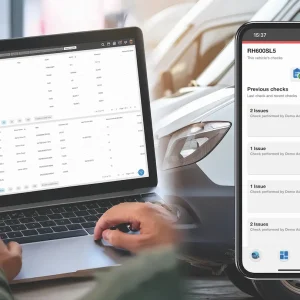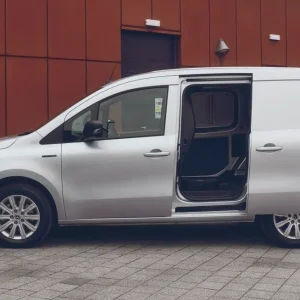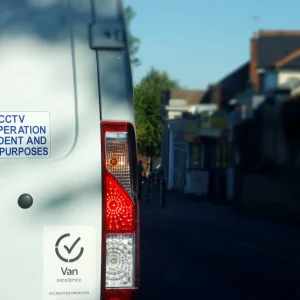
Van owners are engaged in a never-ending battle against thieves eager to steal the contents of their vehicles. Parcels and packages transported by couriers are among their targets, and so are tools.
Insurer Direct Line reports that there were over 24,500 instances of tool theft from a vehicle in 2023, up 14% on 2022. Eighty-three per cent of tradespeople who have been victims say they have lost business through not having the tools available to take on jobs.
Tools to the value of an estimated £16.3m were stolen from vehicles in London alone in 2023, according to the Metropolitan Police.
The tool crime tidal wave has triggered public protests by trades people, with a demonstration organised by campaign group Trades United staged in London’s Parliament Square earlier this year.
Laura Moran, managing director at light commercial security specialist TVL Group, believes the level of tool theft has now reached crisis point.
“For many workers, their tools are their livelihood,” she points out. “Losing them can mean missed jobs, delayed projects and financial hardship, not to mention
the emotional toll of feeling targeted and vulnerable.
“It’s clear that more needs to be done to support tradespeople and protect their essential tools.”
Trades United wants to see increased funding for the police and a complete
ban on sales of tools at car boot sales. Moran agrees.
“The trouble is that tools are too easy to sell on,” she observes. “You see the same people repeatedly turning up at car boot sales with 50 power tools to sell – but how many honest private individuals have that many power tools in their garage?
“The reality is that members of organised crime groups are involved
in this trade,” she insists. “To them, it’s simply a business and we need to see much tougher sentencing.”
Moran advises tradespeople to clearly mark their tools, with ultraviolet marking being one option. So, if they do go on walkabouts, then hopefully the rightful owners will be able to get them back.
“Etching is another way of marking tools, but unfortunately it can be filed off,” she says.
They should also consider investing in better physical security for their vehicle, she advises.
One option is to fit a van’s doors with additional locks, including mechanical hook locks from suppliers such as Locks4Vans. They come with deadlocking hook bolts that hook into the opposing body section, and are particularly suitable for owner-drivers and businesses that rely on their drivers locking their vehicles.
But what if they don’t? “If a van is fitted with a telematics system, then we can link the locks to it so the fleet manager is alerted if the van has been left unlocked,” Moran says. The manager can then send a message to the driver telling them to secure their vehicle.
Alternatively, the van can send an alert direct to the driver’s smartphone telling them to lock the doors.
A business can also consider having electronic slam-locks installed. They secure a door automatically when it is slammed shut.
This type of lock is ideal for parcel delivery companies because drivers can use it to secure the load areas of their vans quickly while they deliver packages, ensuring items aren’t stolen while their backs are turned. Once again, the fleet manager or the driver can be pinged if a door hasn’t been slammed shut.
Unfortunately, the item the driver has dropped off may subsequently go missing if the householder happens to be out. So-called ‘porch piracy’, which describes the theft of parcels from doorsteps, resulted in goods worth over £375m being stolen in 2024, according to Quadient, which supplies parcel lockers.
“Blocks of flats are now prime targets for porch pirates as they use minimum effort for maximum profit, swiping several items at once,” warns Katia Bourgeais-Cremel, director of Quadient’s Lockers Automation Europe operation. They are typically taken from communal areas.
Criminals are said to be following parcels vans in the hope they will drop parcels off at empty homes or that the van driver will leave a door open so they can steal items from the load area.
“Fifty per cent of tool thefts from vans occur in broad daylight in the car parks
of busy supermarkets and DIY stores,” Moran comments.
In addition to hook locks and slam locks, other types of lock include statement locks. Available with anti-cutting and anti-drilling properties, which enable them to stand up to attacks by angle-grinders and drills, they stand out boldly on the door’s surface and act as a visual deterrent to thieves, says Locks4Vans.
“You can also look at having protection plates fitted,” Moran suggests. They defend locks installed by the van manufacturer on the production line against attack; the stainless steel ArmaPlate Sentinel is probably the best-known.
Protection plate suppliers include The Van Lock Store and Van Guard Accessories, which was acquired by van load area racking specialist Bott earlier
this year.
One approach criminals use to force their way into vans is known as ‘peel-and-steal’. Thieves apply pressure to a door’s weakest points allowing it to be levered open.
To fight off this sort of attack Locks4Vans offers a stainless-steel bracket and keep, which it says boosts resistance to peel-and-steal by as much as 3,000%. It can be combined with a hook lock.
Tools and other valuables can be held in a lockable chest secured to the van’s load bed. The Van Vault from Toolstream is a good example, with prices ranging from £300 to £600, depending on how big a chest you require.
Lockable security gates from businesses such as Mundy Van Security are worth investigating too. Made from galvanised steel mesh, they are mounted inside the van’s rear or side sliding doors and provide an additional level of protection.
More vans now are equipped with keyless ignition which can make them vulnerable to theft. Employing a tactic referred to as relay theft, thieves use devices that can interfere with the signal from the key fob, allowing them to open the van’s doors and drive it away, along with its contents.
To prevent this happening, the fob should be kept in a Faraday pouch, which has a metallic lining that blocks the signal. You can buy them for as little as £1.50, but they need to be changed every six months to ensure your fob remains protected.
“TVL’s Faraday pouches are more expensive but will stand up to 10,000 key insertions and last from three to five years,” Moran says.
You can also invest in a lockable box that encases the van’s pedals, she suggests. If a thief cannot get to them, the vehicle cannot be driven away.
Telematics company Teletrac Navman says it can combat relay theft with a secondary relay signal connected to a driver’s identity tag, which is required to start the vehicle. That means thieves have two barriers to overcome.
A combined tracker and immobiliser, the Trackstar S5 iPRO, costs from £599.
Worth investing in is an OBD (On Board Diagnostics) port protector which stops thieves hacking into the vehicle’s electrics and overriding the built-in immobiliser. It can be key or code-operated, and costs £110 to £120.
Sometimes vans must be left with their engine ticking over in order to power auxiliary equipment, leaving them vulnerable to theft.
Maple Fleet Services offers the Keyout Immobiliser, which enables the engine to keep running without the keys in the ignition. If somebody unauthorised attempts to move the vehicle the engine cuts out immediately and will not restart.
Maple also offers the Acer Green immobiliser, which automatically arms and disarms when a transponder carried by the driver gets within range.
Vision on
Vans can be fitted with cameras linked to an onboard telematics system that can be used to monitor the load area, the rear of the vehicle, and the road ahead. As well as enhancing security the footage they generate can be used to defend drivers against specious accusations that their on-highway behaviour caused an accident.
Trakm8 provides integrated camera and telematics packages, and has just installed them in 22 vans operated by Blue Square Marketing.
“We’re seeing growing demand from fleets for what we have to offer,” says Trakm8 fleet and optimisation sales director, Joe Heidari. “It improves fleet safety and reduces claims.”
Track a van using telematics and you can be alerted if it departs from its expected route, or is started up and moved at a time of day when it should be stationary. It may also help to recover it if it is stolen.
A proactive approach to security can help reduce the cost of van insurance says broker Adrian Flux Insurance Services. Beneficial measures include ensuring it is parked somewhere safe – a driveway, or ideally inside a locked garage and installing an alarm, an immobiliser and a tracker.
If you’re looking for a premium discount, then any security device fitted ought to be Thatcham-approved, it advises. Thatcham Research is a not-for-profit organisation funded primarily by the insurance industry.
Maple is one supplier offering a Thatcham Category One alarm. It integrates with the vehicle’s existing immobiliser.
An ultrasonic detector protects the cab, with door, bonnet and ignition triggers.
Other ways of cutting the cost of insurance include accepting a higher voluntary excess, Adrian Flux says. “But make sure you can afford to pay it should you need to make a claim,” a spokesman comments.
If you carry a lot of expensive tools, then if possible, you should take them indoors once your working day has finished and tell your insurer that you do so. That should help cut the cost of your cover.
Don’t put stickers on your van stating that no tools are kept in it overnight however, Adrian Flux advises.
“Despite these stickers being used as a deterrent, you’re actually drawing attention to the fact that there may be valuables in your vehicle,” it says. “And that makes it a higher risk.”





